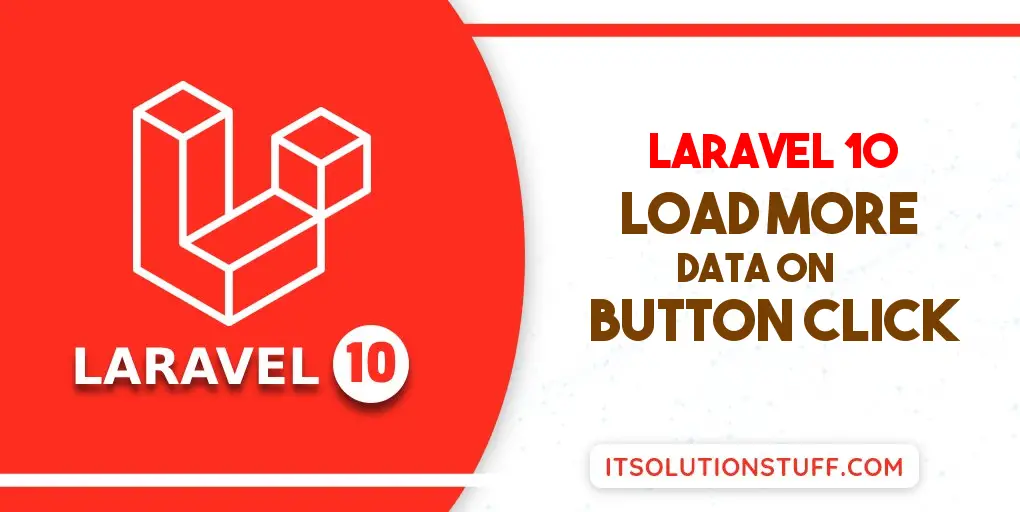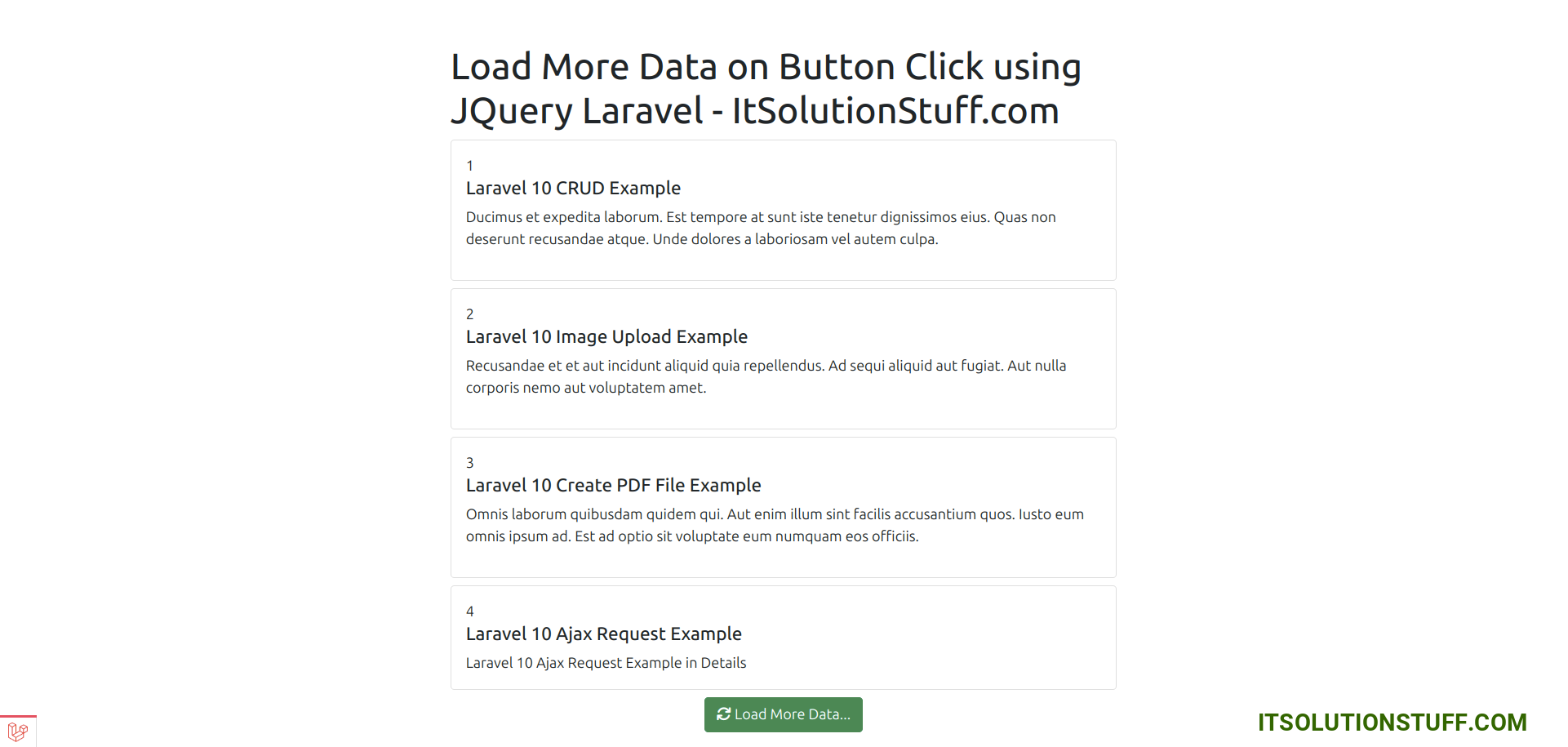Load More Data on Button Click using JQuery Laravel 10
Hi Guys,
I will explain step by step tutorial laravel 10 load more button pagination. In this article, we will implement a load more data on button click using jquery laravel 10. We will use laravel 10 on button load more data. In this article, we will implement a laravel 10 load more button ajax. Let's see below example load more button jquery laravel 10.
In this example, we will create a posts table using migration. Then, we will create a data model for the posts and a factory class to create dummy post data. Finally, we will create a route to load posts and write the code for auto-loading more data on button click event using JQuery AJAX. Let's take a look at a simple step-by-step example.

Step 1: Install Laravel
This step is not required; however, if you have not created the laravel app, then you may go ahead and execute the below command:
composer create-project laravel/laravel example-app
Step 2 : Database Configuration
In this step, we require to make database configuration, you have to add following details on your .env file.
1.Database Username
2.Database Password
3.Database Name
In .env file also available host and port details, you can configure all details as in your system, So you can put like as bellow:
.env
DB_HOST=localhost
DB_DATABASE=homestead
DB_USERNAME=homestead
DB_PASSWORD=secret
Step 3: Create Migration
here, we will create new migration for adding new table posts in users table. so let's run bellow command:
php artisan make:migration create_posts_table
After this command you will find one file in following path "database/migrations" and you have to put bellow code in your migration file for create products table.
<?php
use Illuminate\Database\Migrations\Migration;
use Illuminate\Database\Schema\Blueprint;
use Illuminate\Support\Facades\Schema;
return new class extends Migration
{
/**
* Run the migrations.
*
* @return void
*/
public function up()
{
Schema::create('posts', function (Blueprint $table) {
$table->id();
$table->string('title');
$table->string('slug');
$table->text('body');
$table->timestamps();
});
}
/**
* Reverse the migrations.
*
* @return void
*/
public function down()
{
Schema::dropIfExists('posts');
}
};
Now you have to run this migration by following command:
php artisan migrate
Step 4: Create Model
After create "posts" table you should create Post model for posts, so first create file in this path app/Models/Post.php and put bellow content in Post.php file:
app/Models/Post.php
<?php
namespace App\Models;
use Illuminate\Database\Eloquent\Factories\HasFactory;
use Illuminate\Database\Eloquent\Model;
class Post extends Model
{
use HasFactory;
/**
* Write code on Method
*
* @return response()
*/
protected $fillable = [
'title', 'body', 'slug'
];
}
Step 5: Create Factory Class
This step explains how to generate dummy data using factory; this data loads dynamically on page scroll:
php artisan make:factory PostFactory --model=Post
Further, put the below code in database\factories\PostFactory.php:
database\factories\PostFactory.php
<?php
namespace Database\Factories;
use Illuminate\Database\Eloquent\Factories\Factory;
use App\Models\Post;
use Illuminate\Support\Str;
/**
* @extends \Illuminate\Database\Eloquent\Factories\Factory<\App\Models\Post>
*/
class PostFactory extends Factory
{
/**
* The name of the factory's corresponding model.
*
* @var string
*/
protected $model = Post::class;
/**
* Define the model's default state.
*
* @return array
*/
public function definition(): array
{
return [
'title' => $this->faker->text(),
'slug' => Str::slug($this->faker->text()),
'body' => $this->faker->paragraph()
];
}
}
Open terminal, execute the below commands to generate the test data:
php artisan tinker
Post::factory()->count(20)->create()
Step 6: Create Route
In this is step we need to create routes for display posts and getting posts. so open your "routes/web.php" file and add following route.
routes/web.php
<?php
use Illuminate\Support\Facades\Route;
use App\Http\Controllers\PostController;
/*
|--------------------------------------------------------------------------
| Web Routes
|--------------------------------------------------------------------------
|
| Here is where you can register web routes for your application. These
| routes are loaded by the RouteServiceProvider within a group which
| contains the "web" middleware group. Now create something great!
|
*/
Route::get('posts',[PostController::class,'index'])->name('posts.index');
Step 7: Create Controller
Here,we require to create new controller PostController with index method to display posts view and return data. So let's put bellow code.
app/Http/Controllers/PostController.php
<?php
namespace App\Http\Controllers;
use Illuminate\Http\Request;
use App\Models\Post;
class PostController extends Controller
{
/**
* Write code on Method
*
* @return response()
*/
public function index(Request $request)
{
$posts = Post::paginate(10);
if ($request->ajax()) {
$view = view('data', compact('posts'))->render();
return response()->json(['html' => $view]);
}
return view('posts', compact('posts'));
}
}
Step 8: Create View File
In Last step, let's create posts.blade.php and data.blade.php for display posts list and put following code:
resources/views/posts.blade.php
<!DOCTYPE html>
<html lang="{{ str_replace('_', '-', app()->getLocale()) }}">
<head>
<meta name="csrf-token" content="{{ csrf_token() }}">
<title>Load More Data on Button Click using JQuery Laravel - ItSolutionStuff.com</title>
<link rel="stylesheet" href="https://cdn.jsdelivr.net/npm/bootstrap@5.0.0-beta1/dist/css/bootstrap.min.css">
<link rel="stylesheet" href="https://cdnjs.cloudflare.com/ajax/libs/font-awesome/6.4.0/css/all.min.css" />
</head>
<body>
<div class="container mt-5" style="max-width: 750px">
<h1>Load More Data on Button Click using JQuery Laravel - ItSolutionStuff.com</h1>
<div id="data-wrapper">
@include('data')
</div>
<div class="text-center">
<button class="btn btn-success load-more-data"><i class="fa fa-refresh"></i> Load More Data...</button>
</div>
<!-- Data Loader -->
<div class="auto-load text-center" style="display: none;">
<svg version="1.1" id="L9" xmlns="http://www.w3.org/2000/svg" xmlns:xlink="http://www.w3.org/1999/xlink"
x="0px" y="0px" height="60" viewBox="0 0 100 100" enable-background="new 0 0 0 0" xml:space="preserve">
<path fill="#000"
d="M73,50c0-12.7-10.3-23-23-23S27,37.3,27,50 M30.9,50c0-10.5,8.5-19.1,19.1-19.1S69.1,39.5,69.1,50">
<animateTransform attributeName="transform" attributeType="XML" type="rotate" dur="1s"
from="0 50 50" to="360 50 50" repeatCount="indefinite" />
</path>
</svg>
</div>
</div>
<script src="https://ajax.googleapis.com/ajax/libs/jquery/3.5.1/jquery.min.js"></script>
<script>
var ENDPOINT = "{{ route('posts.index') }}";
var page = 1;
$(".load-more-data").click(function(){
page++;
infinteLoadMore(page);
});
/*------------------------------------------
--------------------------------------------
call infinteLoadMore()
--------------------------------------------
--------------------------------------------*/
function infinteLoadMore(page) {
$.ajax({
url: ENDPOINT + "?page=" + page,
datatype: "html",
type: "get",
beforeSend: function () {
$('.auto-load').show();
}
})
.done(function (response) {
if (response.html == '') {
$('.auto-load').html("We don't have more data to display :(");
return;
}
$('.auto-load').hide();
$("#data-wrapper").append(response.html);
})
.fail(function (jqXHR, ajaxOptions, thrownError) {
console.log('Server error occured');
});
}
</script>
</body>
</html>
resources/views/data.blade.php
@foreach ($posts as $post)
<div class="card mb-2">
<div class="card-body">{{ $post->id }}
<h5 class="card-title">{{ $post->title }}</h5>
{!! $post->body !!}
</div>
</div>
@endforeach
Run Laravel App:
All the required steps have been done, now you have to type the given below command and hit enter to run the Laravel app:
php artisan serve
Now, Go to your web browser, type the given URL and view the app output:
http://localhost:8000/posts
Output:

I hope it can help you...

